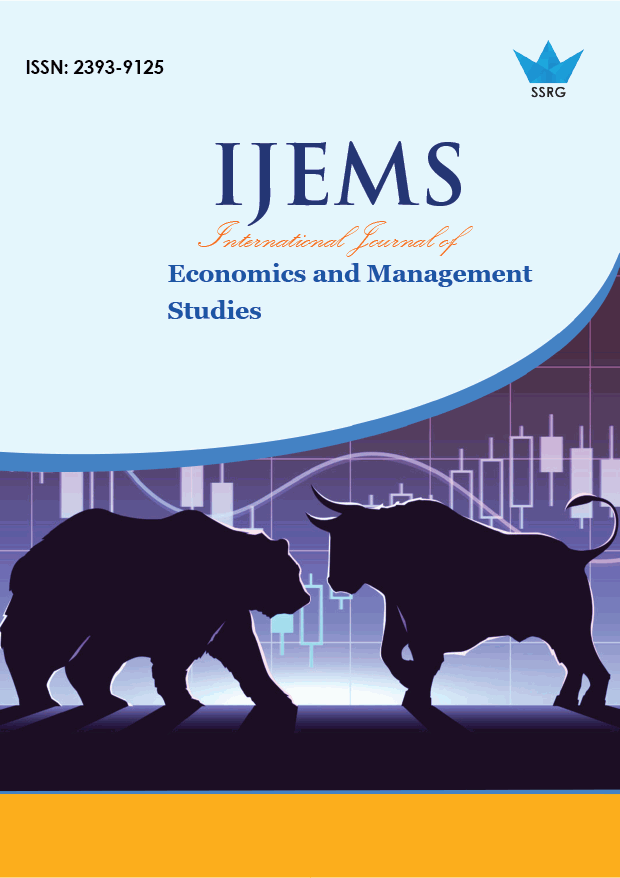Women in Agriculture – Lack of Access to Resources (An Analytical Studyof District Faisalabad, Punjab, Pakistan)

| International Journal of Economics and Management Studies |
| © 2018 by SSRG - IJEMS Journal |
| Volume 5 Issue 10 |
| Year of Publication : 2018 |
| Authors : Saira Akhtar, Shazia Ramzan, Shabbir Ahmad, Wu Huifang, Shakeel Imran, and Haroon Yousaf |
How to Cite?
Saira Akhtar, Shazia Ramzan, Shabbir Ahmad, Wu Huifang, Shakeel Imran, and Haroon Yousaf, "Women in Agriculture – Lack of Access to Resources (An Analytical Studyof District Faisalabad, Punjab, Pakistan)," SSRG International Journal of Economics and Management Studies, vol. 5, no. 10, pp. 16-24, 2018. Crossref, https://doi.org/10.14445/23939125/IJEMS-V5I10P103
Abstract:
The decent work deficit for women in agriculture sector is especially pronounced. One responsible factor is the traditional gender regime which is denying women access to resources almost in every field of life not particularly in the agricultural field. This research paper tries to identify the barriers which hinder the access of women to resources, analyses their impact and explores strategies for overcoming these barriers. Global ratio of women working in agriculture sector is around 43 % which approaches to 70 % in the developing countries, and 80 % in food deficient countries. In the agriculture sector, women in Pakistan are working in cotton, vegetable, maize, tunnel farming, and livestock sub-sectors etc. Women’s contribution varies but provides crucial labor in various activities ranging from planting to harvesting and post-harvest operations. Unfortunately, women work in agriculture is in fact not only taken for granted but also badly ignored due to social, traditional and cultural factors. Their “say” also remains unnoticed while making policies and strategies for agriculture. There is a great need of the support of government to understand the risks and dangers women face while working in the farming sector. It is necessary to include them as agriculture farmers in policies and strategies if improvement is required in the agriculture sector. There is a need to support their enhanced role in decision making, marketing, and management and training programs for their skill enhancement. If effectively engaged and acknowledged, women labor force can be a game changer for the agriculture sector of Pakistan.
Keywords:
Access, Agriculture, Resources, Women, Livelihood, Labor Policy, Decent Work
References:
[1] Govt. of Pakistan. 2010. Economic survey of Pakistan. Ministry of finance, Govt. of Pakistan, Islamabad.
[2] FAO. 2002. Women and food security. An article from website http://www.Fao.org.
[3] Shahrashoub, R., Miller C.1995. WID to GAD: Conceptual shifts in the women and Development Discourse, Occasional Paper 1, United Nations Research Institute for Social Development, United Nations
[4] Nawab Akbar, F. 1997. The role of rural women in the past decade. Journal of Agricultural Economics and Development, conference papers, women participation and Agriculture 1400, Journal No. 3, Publishing Ministry of Agriculture, P. 186.
[5] Ahmad. 2001. Report on mechanization & technological adoption: scaling up micro enterprises to small scale enterprises. Monograph series on social science. Serdang: Penerbit Universities Putra Malaysia.
[6] FAO.2011. The state of food and agriculture. Women in agriculture: closing the gender gap for development. (Online available on: www.fao.org/docrep).
[7] IFAD. 2007. Empowerment of the Poor: The Replacement of a System of Peoples‟ Participation in Public initiated Development by One of Public Participation in People-initiated Development. From http://www.ifad.org/events/past/hunger /empower. html (Retrieved April 20, 2008). International Fund for Agricultural Development.
[8] Peter, G. 2006. Gender Roles and Relationships: Implications for Water Management. Physics and Chemistry of the Earth, 31: 723-730,
[9] Rahman, S. 2000. Women are Employment in Bangladesh Agriculture: Composition, Determinants and Scope. Journal of Rural Studies, 16: 497-507.
[10] Acharya, M. 2003. Efforts at Promotion of Women in Nepal. Kathmandu: Tanka Prasad Acharya Foundation.
[11] Khan, A. 2008. Tackling the failure of microfinance effort through amalgamating microfinance with charity: two variable alternatives in the context of Pakistan. Australasian accounting business & finance journal 3:96.
[12] Suguna, B. 2006. Empowerment of Rural Women through Self Help Groups. New Delhi: Discovery Publishing House.
[13] Waheed, S. 2009. Does rural micro credit improve well-being of borrowers in the Punjab (Pakistan)? Pakistan economics and social review 47(1)31-47.
[14] Verveer, M. 2011. The vital role of women in agriculture and rural development. Food and agriculture organization, Rome, Italy, June 27.
[15] Moazzami, M., and Haidari, T. A. "Coverage and sustainability of microcredit programs, case study of rural women micro-credit fund" Research Center for Rural Women and Rural Affairs Ministry of Agriculture, 2005.
[16] Davison, J. 1988. Agriculture, Women and the Land: The African Experience. Colorado, Westview Press
[17] ILO. 2002. Gender equality at the heart of decent work. Report VI: Geneva. (Available atLaboursta.ilo.org/) LABOURSTA>international labor organization.
[18] Agarwal, B. 2003. Gender and land rights revisited: Exploring new prospects via the state, family, and market. Journal of Agrarian Change, 3(1-2):184–224.
[19] IFAPD. 2005. Give credit to rural women. http://www.copacgva.org.
[20] ILO/WHO (2009). The Social Protection Floor: A Joint Crisis Initiative of the UN Chief Executives Board for Coordination on the Social Protection Floor.
[21] Evers and Walters, (2000). Improving women farmers‟ access to extension services, in: improving agricultural extension, a reference manual. Swanson, B.E. Bentz, R.P. and Sofranco, A.J. (FDS)
[22] Almaz, A. 2007. "Labour Markets as Gendered Institutions: Equality, Efficiency and Empowerment Issues." World Development, Vol.27, No. 3, pp.611-27.
[23] Tsikata, D. 2004. Gender, Land Rights and Inheritance Securing Women‟s Land Rights: Approaches, Prospects and Challenges, Working Group 2. Land in Africa Conference, London. November 8-9.
[24] World Bank (2007a). World Development Report 2008: Agriculture for Development. Washington, DC: The World Bank.
[25] IFAD. 2008. Women‟s access to productive resources, contribution of the international funds for agricultural development (IFAD)

 10.14445/23939125/IJEMS-V5I10P103
10.14445/23939125/IJEMS-V5I10P103